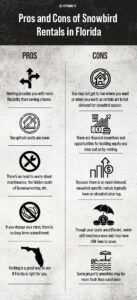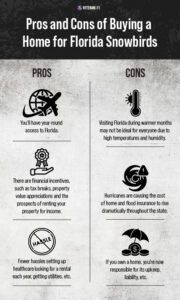EVERYTHING A FLORIDA SNOWBIRD NEEDS TO KNOW TO MIGRATE

Every year between October and May, one of the most fascinating annual migrations in America occurs—the Florida snowbird. The season can vary on a personal level depending on when and if Northerners looking to escape the cold decide to call the Sunshine State home during the colder months of the year. Although a relatively common practice, being a snowbird comes with a lot of questions and considerations for those participating. A popular choice among Veterans and non-Vets alike, going to Florida can be a great opportunity to escape the cold but planning ahead is key. Our guide will help you get ready for an adventure in the sunshine unlike any other.
Table of Contents:
- What Is a Snowbird in Florida?
- Moving to Florida as a Snowbird
- How Much Does It Cost to Snowbird in Florida?
What Is a Snowbird in Florida?
The Florida snowbird is a nickname given to people who temporarily move to the state during the winter months. Typically, snowbirds in Florida are older, retired individuals from Northern parts of the United States or those who reside in Canada. However, it’s worth noting that this is not always the case and particularly with the advent of technology and working from home, more and more younger families have the opportunity to head South for the winter. It’s believed that there are at least 1 million snowbirds in Florida each year who spend no less than a month in the state while escaping the cold.
Why People Head to the Sunshine State
Contrary to what you might think, the move of snowbirds to Florida is more complex than appears on the surface. Here are some of the obvious and not-so-obvious reasons people flock to the Sunshine State in the fall and winter:
Warmer Temperatures
Depending on where you decide to stay in Florida, snowbirds can find a literal 100°F difference in temperature some days. You won't find much snow as most cities in the Sunshine State have never recorded measurable snowfall in their history. So, you can say goodbye to icy roads and sidewalks as the average highs remain in the 60s and 70s. If trading in blizzards and icicles for the comfort of sand beneath your feet on the beach is your vibe, Florida has a lot to offer. Still, it would be easy to assume that Florida snowbirds are all simply looking to enjoy a warmer lifestyle, triggering the annual move. While this is certainly part of it, there’s more to it than just escaping the snow and the cold.
Staying Active
Going for a walk, run, bike ride, etc. when the highs won’t touch the 30s isn’t as inviting as it is with more reasonable temperatures and Florida is perfect for providing in this regard. Not only is the weather nicer but there are so many activities to help snowbirds stay active. Some examples include:
- Birdwatching
- Cycling
- Going on a bike ride
- Kayaking and paddleboarding
- Pickleball and tennis
- Playing golf
- Walking on the beach, through trails, or even at the mall
Furthermore, there are also plenty of attractions found throughout the state to explore, such as Florida’s 47 National Historic Landmarks (NHLs), 11 national parks, and 175 state parks. No matter your interest, you’ll also find local theaters putting on shows, multiple amusement parks, festivals, museums, and much more offering visitors new, engaging forms of entertainment every time. Finally, Florida is known for its snowbird and retirement communities. These range from The Villages, FL, to smaller collectives inspiring social engagement with many activities.
Financial Incentives
Everyone has factors affecting their finances but Florida snowbirds sometimes move to the state because of the many potential financial incentives available. Generally, you’ll find the Sunshine State is as affordable as anywhere in the U.S. if not cheaper. There is also no state income tax. It’s not as simple as moving to Florida for a month and reaping the benefits but there are methods of finding ways to make the system work for you.
Quality of Life
Defining the quality of life for a state is always a bit subjective; however, Florida continues to rank as one of the highest states for this metric. Part of what makes this true is that Florida provides an affordable place to live and travel. This means your family can easily visit you if you decide to leave the north for a few months out of the year. It also means that your disposable income can go farther and for many, this means enjoying more of life’s leisure and luxuries. The Sunshine State is also a better culinary draw than one might think, offering a diverse mix of mouthwatering cuisines available. Especially for those near the Gulf or Atlantic Ocean, fresh seafood is readily available. However, when you’re not eating redfish, shrimp, and stone crab in every way imaginable, a host of Latin flavors from Cuba, Puerto Rico, Colombia, and more await.
Moving to Florida as a Snowbird
Whether it’s on a temporary or semi-permanent basis, moving to Florida for the snowbird season takes some planning. For example, if you are looking to book one of the many snowbird rentals rather than purchasing a property or renting a home or apartment in a traditional sense, you’re going to need to plan six to twelve months in advance. In addition to finding the right place to live, you’re going to need to understand how healthcare coverage works, with even larger obstacles for those migrating from out of the country.
Finding the Right Property
The key to finding the right property is all about knowing what you need, and what you want, and choosing a home that provides necessities and substance over flash. It’s important to weigh the pros and cons of renting versus buying along with picking the right city to live in are great places to start but it’s a bit more involved than this. Here are some things to keep in mind before you decide on where to live as a snowbird:
The Pros and Cons of Renting as a Florida Snowbird

The Pros and Cons of Purchasing a Second Home in Florida

Healthcare and Coverage
Even if you aren’t spending too much time in Florida, for many snowbirds, healthcare and insurance are major concerns. Depending on where you live and the type of health insurance you have, along with whether or not you have Medicare, your access, costs, and overall experience with the healthcare system will vary. There’s also the bother of finding a network of doctors that not only works for you but also accepts your coverage. Private insurance is available for those who don’t have access to coverage that works in Florida, but you’ll need to factor in these costs and stress factors before making your way down. Talking to others about their experience and reaching out to your insurance company as a resource will help you transition and avoid a lapse in coverage.
How Much Does It Cost to Snowbird in Florida?
When you compare the cost of living in Florida to living anywhere else in the United States, you’ll notice that there is little difference. The Sunshine State is on par with the U.S., though individual costs will vary. However, like any state, where you live matters when it comes to expenses. For instance, Miami isn’t just the most expensive city in Florida but also ranks as the third most expensive city in the entire country. With that being said, there are plenty of affordable options to choose from. Below is a breakdown of some of the most affordable places for snowbirds in Florida. Keep in mind for the statistics measuring affordability for groceries, healthcare, transportation, and overall, anything under 100 is below the national average cost whereas anything over 100 is above:
Bartow
- Avg. Monthly Rent (Two Bedroom): $970
- Avg. Home Value: $245,600
- Groceries: 102.2
- Healthcare: 100.9
- Transportation: 85.0
- Overall: 91.6
Bartow is about 46 miles east of Tampa and only about 13 miles southeast of Lakeland, meaning if you need access to airports, city amenities, or the beach, you’re only a short drive away. With that being said, our first stop is inland, so if being beachside is important to you, other cities on our list may be more your style. Living in the City of Oaks and Azaleas comes with a unique Southern charm and several local attractions, such as the L.B. Brown House and Museum, Bartow Golf Course, and Heritage Peace River Landing. Just north of the city is Lake Hancock, the perfect place for fishing and boating nearby. Combined with the town’s antique shops, parks, and many local trails, Bartow offers an active lifestyle and small-town charm that is exciting and affordable.
Daytona Beach
- Avg. Monthly Rent (Two Bedroom): $1,330
- Avg. Home Value: $245,100
- Groceries: 97.9
- Healthcare: 102.7
- Transportation: 88.0
- Overall: 94.9
The Daytona International Speedway becomes electric every February as it hosts the Daytona 500; however, the World's Most Famous Beach has much more to offer than a day at the races. You’ll find easy access to the Atlantic Ocean as the name suggests, along with plenty of creeks and rivers to explore, with weather generally permitting such recreation. The city also boasts easy access to golfing and horseback riding while featuring an international airport (DAB), the Museum of Arts & Sciences, and a host of local eateries offering fresh seafood dishes. Of any city on our list, Daytona Beach is the most expensive for Florida snowbirds, and the price of housing will vary significantly depending on where you stay within the metro. However, you’ll find plenty of affordable housing with attractive amenities to be found. If there is one consideration to remember, although recent years have had more family-friendly focuses in comparison, Daytona Beach is known far and wide for its crowded, eccentric parties during spring break.
Fort Pierce
- Avg. Monthly Rent (Two Bedroom): $1,230
- Avg. Home Value: $274,000
- Groceries: 101.6
- Healthcare: 103.7
- Transportation: 88.1
- Overall: 98.6
It doesn’t get much more Florida than Fort Pierce. Not only is the city an affordable, oceanside slice of paradise, but the connection to the military, city amenities, and ample recreation really put the birthplace of the Navy SEALs up there as one of your best options. The Treasure Coast International Airport (FPR) makes for easy travel. Fort Pierce Inlet State Park and Frederick Douglass Memorial Park are just waiting to be explored, and there are several additional local attractions. These include the Heathcote Botanical Gardens as well as the National Navy UDT-SEAL Museum. Snowbirds looking for the perfect bite will have no problem among the many local restaurants, and vendors at the Fort Pierce Farmers Market, or sipping local wines at the Summer Crush Vineyard and Winery.
Ocala
- Avg. Monthly Rent (Two Bedroom): $1,150
- Avg. Home Value: $278,500
- Groceries: 98.1
- Healthcare: 97.6
- Transportation: 82.1
- Overall: 87.0
Found 23 miles north of The Villages and about 38 miles south of Gainesville, living in Ocala puts you far from the beaches but in the middle of great Florida snowbird communities. However, you are also in a prime location where Daytona Beach, Tampa, and Orlando are all within 100 miles, providing a variety of entertainment options. If you love equestrian activities, you’ll find plenty. Known as the Horse Capital of the World, Ocala is home to more than 600 horse farms that have produced many national champions, including six Kentucky Derby winners. Parks, museums, and historical landmarks are found all over Brick City, along with glass bottom boat tours providing an up close and personal look at nature’s wonder known as the manatee. Downtown features plenty of local artisans and eateries, food tours, and the Ocala Downtown Market to enjoy.
Pensacola
- Avg. Monthly Rent (Two Bedroom): $1,120
- Avg. Home Value: $240,000
- Groceries: 96.6
- Healthcare: 98.1
- Transportation: 89.9
- Overall: 89.0
The truth is, Pensacola and Pensacola Beach offer you so much to do, that Florida snowbirds won’t really need to leave the area. You’ll find plenty of delicious food in the area influenced by the Gulf Coast, the Deep South, and specifically, New Orleans. The beaches are some of Florida’s most desirable, known by many as the Emerald Coast for its unique, greenish hue. You’ll also find ample opportunities for birdwatching, viewing the Blue Angels soar, charter fishing, diving, swimming, paddleboarding, and much, much more. But the location also provides prime real estate for traveling throughout other sections of the Emerald Coast, such as nearby Navarre Beach, Destin, and of course, the iconic 30A Highway. Within the City of Five Flags, Florida snowbirds will find plenty of history and scientific museums, the Veterans Memorial Park Pensacola, and stunning views of the bays and the Gulf of Mexico.
Establishing a Residency as a Florida Snowbird
Becoming a resident of Florida is popular among snowbirds, as you can save on income tax. For those who spend a considerable amount of time between their home and their snowbird destination, you’ll need to understand what it takes to be considered a Floridian, legally:
- Submit a Declaration of Domicile in the county you live in while in Florida. P.O. boxes won’t cut it. You’re going to need to have a physical mailing address. This is the address you’ll also need to use on tax returns, legal documents, and your passport.
- Don’t forget to get your Florida driver’s license and vehicle registration.
- Become a registered voter within the state.
- Stay current on all of your property taxes if you own a home. You should also file for a homestead exemption.
- Moving valuable pieces of personal property, such as jewelry, can also help.
While you don’t need to do all of these things, they provide proof of moving to Florida as a true resident.
Income Tax and the 183-Day Rule
Florida doesn’t have an income tax and if you’d like to take advantage of this, you’re going to have to do some things in order to legally qualify. A popular threshold used by states is the 183-day rule, in which you’ll need to live in Florida for over six months, and in some cases, you must become a resident. In order to become a Florida resident for tax purposes, snowbirds will need to reside in the state for at least 183 days. Keep in mind that if you visit another state for work or pleasure, even if you return to Florida the same day, your travel day isn’t counted as a day of residency in the Sunshine State, even if you spend the night. Ultimately, working with a tax professional is the best bet for all Florida snowbirds who may stay in the South a little longer than most.
Registering Your Vehicle and Getting Your License
Anyone living in Florida has to get a driver’s license within 30 days of becoming a resident and must register their vehicle within 10 days. You can apply for a license or ID at your local Florida Highway Safety and Motor Vehicles office. When applying for a driver’s license, you must pass a vision test and might also need to take a written or road test. There are fees to pay, and you need to provide certain documents that vary based on your citizenship status. For your vehicle’s title and registration, if there is a lien on your car, contact the lienholder to transfer the title to Florida. If they won't transfer it, you still have to register your car. Ask the lienholder for a letter saying they won't transfer the title, then bring that letter to your local motor vehicle service center. If they do agree to transfer the vehicle’s title, go to your local motor vehicle service center and fill out HSMV form 82040. For vehicles that don’t have a lien, you’ll need to have the right documentation, which can vary. Here are some commonly needed documents to bring to your local motor vehicle service center:
- A valid ID.
- Proof of auto insurance in Florida.
- The original out-of-state title.
- A completed HSMV form 82040.
Additionally, you need a physical inspection of your car’s vehicle identification number (VIN) on the HSMV form 82040 or a completed HSMV form 82042. Your vehicle’s VIN must be physically inspected and verified. This is done by either a licensed Florida dealer, an employee of the county tax collector, an employee of the Division of Motorist Services Compliance Examiner, law enforcement, or military police.
Car Insurance for Snowbirds
As you can see, in most cases, it makes sense for Florida snowbirds to register their vehicles and purchase auto insurance. It’s a requirement to have car insurance if you stay in Florida for over 90 days at a time. Additionally, your policy must provide minimum coverage of at least $10,000. This is for both personal injury protection (PIP) and property damage liability (PDL).
Florida Snowbird Season Has a Lot to Offer
No matter which method you choose or how long you stay, being a Florida snowbird is an exciting way to ditch the cold and enjoy your winter months from a whole new perspective. The key to finding the right spot for your winter migration is preparing early, creating a plan, and sticking to it. Whether it’s your new home or a temporary place of refuge, Florida has a lot to offer anyone making the journey. Sources: HOW MANY NATIONAL PARKS IN FLORIDA?: 11 FABULOUS FLORIDA NATIONAL PARKS, The Parks Expert. Accessed June 2024. https://parksexpert.com/florida-national-parks/ Florida Department of Environmental Protection, Division of Recreation and Parks. Accessed June 2024. https://floridadep.gov/parks Best States Rankings, U.S. News. Accessed June 2024. https://www.usnews.com/news/best-states/rankings Comparing The Cost of Buying vs. Renting a Winter Home in Florida, Showcase Properties of Central Florida. Accessed June 2024. https://www.showcaseocala.com/cost-buying-vs-renting-florida-home/ Most Expensive Places to Live in the U.S. in 2024-2025, U.S. News. Accessed June 2024. https://realestate.usnews.com/places/rankings/most-expensive-places-to-live Cost of Living, BestPlaces. Accessed June 2024. https://www.bestplaces.net/cost_of_living/city/fl Florida Residency Requirements, Alper Law. Accessed June 2024. https://www.alperlaw.com/florida-asset-protection/florida-residency/ New Resident – Welcome to Florida!, FLHSMV. Accessed June 2024. https://www.flhsmv.gov/new-resident/ Suggested reads:
BY BUDDY BLOUIN
Buddy Blouin is a Contributing Writer at VeteranLife.com
Buddy Blouin is a Contributing Writer at VeteranLife.com



